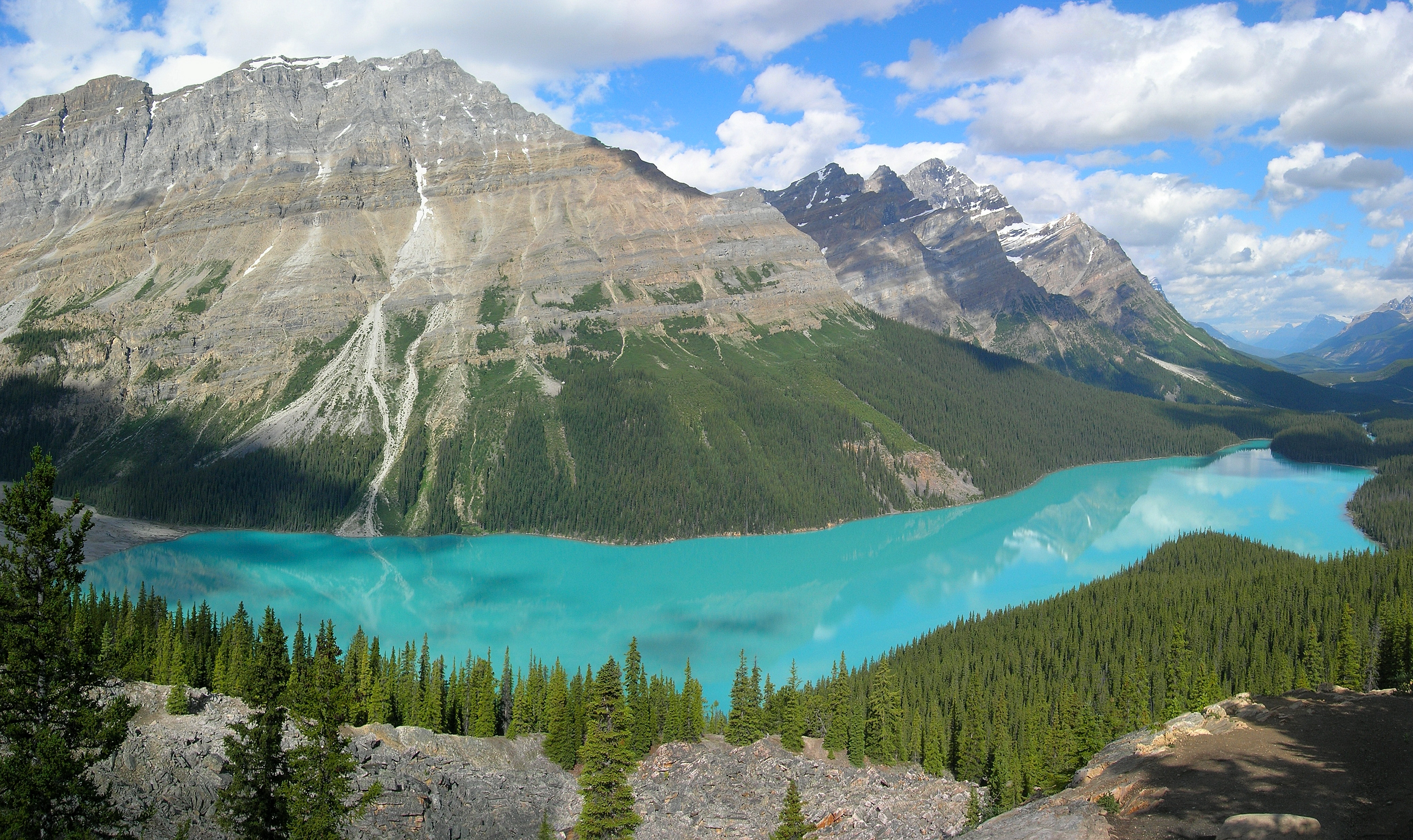
Environment
Since the 19th century, humans have impacted Banff's environment through introduction of non-native species, controls on other species, and development in the Bow Valley, among other human activities. Bison once lived in the valleys of Banff, but were hunted by indigenous people and the last bison were killed off in 1850s. In 2017 a small herd of sixteen plains Bison were reintroduced into an eastern section of the park.[83] Elk are not indigenous to Banff, and were introduced in 1917 with 57 elk brought in from Yellowstone National Park.[84] The introduction of elk to Banff, combined with controls on coyote and wolves by Parks Canada beginning in the 1930s, has caused imbalance of the ecosystem.[84] Other species that have been displaced from the Bow Valley include grizzly bears, cougars, lynx, wolverine, otter, and moose. Beginning in 1985, gray wolves were recolonizing areas in the Bow Valley.[85] However, the wolf population has struggled, with 32 wolf deaths along the Trans-Canada Highway between 1987 and 2000, leaving only 31 wolves in the area.[86]
The population of bull trout and other native species of fish in Banff's lakes has also dwindled, with the introduction of non-native species including brook trout, and rainbow trout.[87] Lake trout, westslope cutthroat trout, and Chiselmouth are rare native species, while chinook salmon, White sturgeon, Pacific lamprey, and Banff longnose dace are likely extirpated locally.[88] The Banff longnose dace, once only found in Banff, is now an extinct species.[88]
Wildlife overpass
The Trans-Canada Highway, passing through Banff, has been problematic, posing hazards for wildlife due to vehicle traffic and as an impediment to wildlife migration. Grizzly bears are among the species impacted by the highway, which together with other developments in Banff, has caused fragmentation of the landscape. Grizzly bears prefer the montane habitat, which has been most impacted by development. Wildlife crossings, including a series of underpasses, and six wildlife overpasses, have been constructed at a number of points along the Trans-Canada Highway to help alleviate this problem.[89]
Fire management
Parks Canada management practices, notably fire suppression, since Banff National Park was established have impacted the park's ecosystem. Since 1983, Parks Canada has adopted a strategy that employed prescribed burns, which helps to mimic effects of natural
fires.[90][91]Transportation
Banff National Park is bisected by two highways that cross the Alberta/British Columbia border while another provides a third access within Alberta. The Trans-Canada Highway (Highway 1) bisects the park in an east-west direction, connecting it to Vancouver to the west and Calgary to the east. Highway 93 bisects the park in a north-south direction, connecting it to Cranbrook to the south and Jasper to the north. The portion of Highway 93 north of Lake Louise is known as the Icefields Parkway whereas the portion southwest of Castle Junction is known as the Banff-Windermere Parkway. Highway 11 (the David Thompson Highway) connects the Icefields Parkway at Saskatchewan River Crossing to Rocky Mountain House to the northeast. Within the park, Highway 1A, also known as the Bow Valley Parkway, loosely parallels Highway 1 between Banff and Lake Louise.[92][93]
Other transportation facilities within Banff National Park include a Canadian Pacific rail line that generally parallels Highway 1 and an airport known as the Banff Park Compound Heliport.[94]
Development
In 1978, expansion of Sunshine Village ski resort was approved, with added parking, hotel expansion, and development of Goat's Eye Mountain. Implementation of this development proposal was delayed through the 1980s, while environmental assessments were conducted. In 1989, Sunshine Village withdrew its development proposal, in light of government reservations, and submitted a revised proposal in 1992. This plan was approved by the government, pending environmental review. Subsequently, the Canadian Parks and Wilderness Society (CPAWS) filed a court injunction, which halted the development.[95] CPAWS also put pressure on UNESCO to revoke Banff's World Heritage Site status, over concerns that developments were harming the park's ecological health.[96]
Banff-Bow Valley Study
While the National Parks Act and the 1988 amendment emphasize ecological integrity, in practice Banff has suffered from inconsistent application of the policies.[67] In 1994, the Banff-Bow Valley Study was mandated by Sheila Copps, the minister responsible for Parks Canada, to provide recommendations on how to better manage human use and development, and maintain ecological integrity.[97] While the two-year Banff-Bow Valley Study was underway, development projects were halted, including the expansion of Sunshine Village, and the twinning of the Trans-Canada Highway between Castle Junction and Sunshine.

The panel issued over 500 recommendations, including limiting the growth of the Banff townsite, capping the town's population at 10,000, placing quotas for popular hiking trails, and curtailing development in the park.[67] Another recommendation was to fence off the townsite to reduce confrontations between people and elk.[98] The proposed fencing was also intended to reduce access to this refuge for elk from predators, such as wolves that tended to avoid the townsite. Upon release of the report, Copps immediately moved to accept the proposal to cap the town population. She also ordered a small airstrip to be removed, along with a buffalo paddock, and cadet camp, that inhibited wildlife movement.[99]
In response to concerns and recommendations raised by the Banff-Bow Valley Study, a number of development plans were curtailed in the 1990s. Plans to add nine holes at the Banff Springs Golf Resort were withdrawn in 1996.[100]
Canmore
With the cap on growth in the town of Banff, Canmore, located just outside the Banff boundary, has been growing rapidly to serve increasing demands of tourists. Major development proposals for Canmore have included the Three Sisters Golf Resorts, proposed in 1992, which has been the subject of contentious debate, with environmental groups arguing that the development would fragment important wildlife corridors in the Bow Valley.[101]
